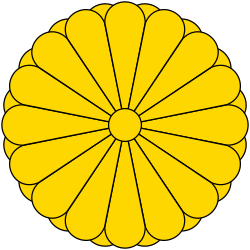Minister of the Left
Government position in pre-modern Japanese imperial court From Wikipedia, the free encyclopedia
The Minister of the Left (左大臣, Sadaijin)[1] was a government position in Japan during the Asuka to Meiji era. The Asuka Kiyomihara Code of 689 marks the initial appearance of the Sadaijin in the context of a central administrative body called the Daijō-kan (太政官, Council of State).[1] This early Daijō-kan was composed of the three ministers—the Daijō-daijin (太政大臣, Chancellor of the Realm), the Sadaijin and the Udaijin (右大臣, Minister of the Right).[2] The position was consolidated in the Taihō Code of 702.
| Premodern Japan | |
|---|---|
 | |
| Daijō-daijin | |
| Minister of the Left | Sadaijin |
| Minister of the Right | Udaijin |
| Minister of the Center | Naidaijin |
| Major Counselor | Dainagon |
| Middle Counselor | Chūnagon |
| Minor Counselor | Shōnagon |
| Eight Ministries | |
| Center | Nakatsukasa-shō |
| Ceremonial | Shikibu-shō |
| Civil Administration | Jibu-shō |
| Popular Affairs | Minbu-shō |
| War | Hyōbu-shō |
| Justice | Gyōbu-shō |
| Treasury | Ōkura-shō |
| Imperial Household | Kunai-shō |
When the Emperor and the nobility held real power, the Sadaijin was the highest permanent position in the Daijō-kan, the central organ of the state. The higher-ranking 'Daijō-daijin was not a permanent position, but was only appointed when a suitable person was found.[3] The Sadaijin was the Senior Minister of State, overseeing all functions of government with the Udaijin as his deputy.[4]
During the Heian period (794-1185), from the middle of the 9th century, the Fujiwara clan began to marry off their daughters to the emperor and assume the positions of Sesshō (摂政, Imperial Regent for Minor Emperors) and Kampaku (関白, Imperial Regent fo Adult Emperors), thereby excluding other clans from the political centre and increasing their political power. From the 10th century, the Fujiwara clan monopolised the positions of Sesshō and Kampaku. However, at the end of the 10th century, Fujiwara no Michinaga, who established the heyday of the Fujiwara clan became Sadaijin, a position of real power, rather than Kampaku, the highest nominal position. The duties of the Sesshō and Kampaku were to convey to the emperor the policies formulated by the Sadaijin and other senior officials of the Daijō-kan, and to convey the emperor's decisions to them. As regents of the emperor, the Sesshō and Kampaku sometimes made decisions on behalf of the emperor, but their positions were not defined by law and they had no specific political authority. The Sadaijin, on the other hand, was the highest permanent position in the Daijō-kan, the country's highest authority for planning and deciding important political matters, which is why Michinaga chose the Sadaijin.[5]
From the Kamakura period (1185-1333), when the warrior class came to power in Japan, this government position became an honorary position with no real authority.[3] At the time of Oda Nobunaga's appointment as Udaijin during the Azuchi-Momoyama period, the only members of the warrior class who had previously been appointed to imperial court posts higher than Udaijin were Taira no Kiyomori and Ashikaga Yoshimitsu as Daijō-daijin and Ashikaga Yoshinori and Ashikaga Yoshimasa as Sadaijin.[6]
See also
References
Further reading
Wikiwand - on
Seamless Wikipedia browsing. On steroids.
